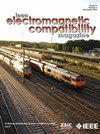Estimating the Perception Threshold of Electrostimulation and Heating for Radiofrequency Contact Current
IF 2
3区 计算机科学
Q3 ENGINEERING, ELECTRICAL & ELECTRONIC
IEEE Transactions on Electromagnetic Compatibility
Pub Date : 2024-11-05
DOI:10.1109/TEMC.2024.3483168
引用次数: 0
Abstract
Radiofrequency contact current occurs when a human touches objects with different electrical potentials. For emerging wireless power transfer systems, this type of exposure is potentially more restrictive than direct exposure. The limits for contact current are prescribed in the international guidelines for human protection from electromagnetic fields, but its rationale is limited compared with that for direct field exposure. In this article, the perceptional threshold for electrostimulation and heating was evaluated based on computational dosimetry from 10 kHz to 10 MHz. First, the time course of the temperature rise was calculated until each subject perceived the contact current. Second, the perception of current was estimated considering the nerve activation modeling. The computationally estimated current threshold for nerve activation was consistent with the measured data at 100 kHz and increased linearly with increasing frequency, which was contrary to the measured threshold for perception above 300 kHz. By contrast, the estimated perceptual temperature increase was smaller at 100 kHz than at 300 kHz and above. These results indicate that the transient frequency of the threshold for stimulation and heating lies between 100 and 300 kHz, supporting the transition frequency of contact current in the international guidelines.估计射频接触电流的电刺激和加热感知阈值
当人体接触具有不同电位的物体时,就会产生射频接触电流。对于新兴的无线电力传输系统,这种类型的暴露可能比直接暴露更具限制性。人体电磁场防护国际准则规定了接触电流的限值,但与直接接触电磁场相比,其原理有限。在这篇文章中,电刺激和加热的感知阈值是基于10 kHz到10 MHz的计算剂量学来评估的。首先,计算温度上升的时间过程,直到每个受试者感知到接触电流。其次,结合神经激活模型对电流感知进行估计。计算估计的神经激活电流阈值与100 kHz时的测量数据一致,并且随着频率的增加而线性增加,这与300 kHz以上的感知阈值相反。相比之下,在100 kHz时估计的感知温度升高比在300 kHz及以上时要小。这些结果表明,刺激和加热阈值的瞬态频率在100 ~ 300 kHz之间,支持国际准则中接触电流的过渡频率。
本文章由计算机程序翻译,如有差异,请以英文原文为准。
求助全文
约1分钟内获得全文
求助全文
来源期刊
CiteScore
4.80
自引率
19.00%
发文量
235
审稿时长
2.3 months
期刊介绍:
IEEE Transactions on Electromagnetic Compatibility publishes original and significant contributions related to all disciplines of electromagnetic compatibility (EMC) and relevant methods to predict, assess and prevent electromagnetic interference (EMI) and increase device/product immunity. The scope of the publication includes, but is not limited to Electromagnetic Environments; Interference Control; EMC and EMI Modeling; High Power Electromagnetics; EMC Standards, Methods of EMC Measurements; Computational Electromagnetics and Signal and Power Integrity, as applied or directly related to Electromagnetic Compatibility problems; Transmission Lines; Electrostatic Discharge and Lightning Effects; EMC in Wireless and Optical Technologies; EMC in Printed Circuit Board and System Design.

 求助内容:
求助内容: 应助结果提醒方式:
应助结果提醒方式:


